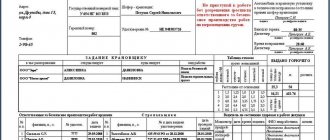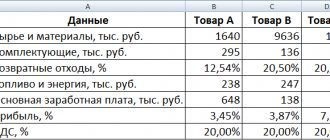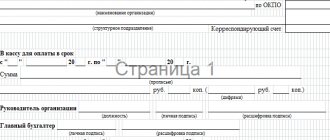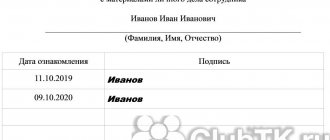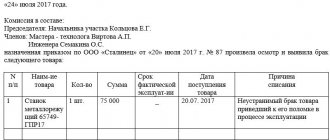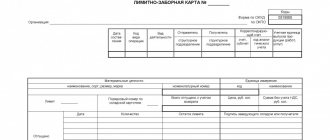Personal matter concept
It is a file of documents grouped for each employee and stapled into a single folder with an inventory.
Formation of personal files is mandatory only for state bodies and municipal authorities. Their compilation and maintenance at other enterprises is at the discretion of the company administration.
This responsibility is assigned to the personnel department, which begins the employee’s personal file at the time of his hiring and closes it upon dismissal. It includes the employee’s personal data, documents prepared at the enterprise itself, etc.
The main regulatory rules are GOST 51141-98 and 17914-72, as well as federal laws on public service. But their requirements are mandatory for establishments and institutions. Other companies can use them in their work, or carry out registration of personal files using their own methods.
However, all enterprises are subject to the provisions of the Personal Data Law, according to which the employer is recognized as the data processor, and therefore he must ensure the protection of the personal information of his employees and prevent its disclosure.
Therefore, personal files should be stored in places where access to unauthorized employees of the enterprise is limited. And requests for information contained in a personal file must be controlled and recorded in special registers. Unauthorized disclosure of personal information entails bringing the company to administrative liability.
The need to manage personal affairs
In government organizations
Federal and municipal laws oblige specialists of budgetary organizations and institutions to draw up and maintain a personal file for each of their employees and employees. This is necessary to systematize information and documents on the personnel of these institutions, as well as to fulfill the requirements of certain laws.
In private companies
The norms of the Labor Code of the Russian Federation do not provide for the obligation of a company to maintain the personal affairs of those working at the enterprise. But such a need can be determined by higher organizations and owners.
When deciding on the management of a personal file, the principle of expediency must be used. In small enterprises, personal files of employees are, as a rule, filed with the management of the company - the director, his deputy, the chief accountant, his deputy.
Due to convenience, most companies draw up a personal file for each of their employees.
Registration and maintenance of personal files
The employee's file is opened at the time of his/her appointment. The first to be tampered with is the personal card issued to the employee, which contains, in addition to basic information about him, a photograph of the employee. Next, all copies of documents submitted by the employee are filed. This also includes the forms he fills out when registering.
Throughout the entire activity at the enterprise, responsible officials include in chronological order the documentation related to him, for example, various statements, reports, explanatory notes. Orders issued at an enterprise regarding personnel in relation to an employee do not need to be sewn into the folder with his file if they are recorded in a personal card. You can file extracts from these documents into your file.
All sheets of the personal file must have continuous numbering.
Upon termination of the employment contract, the folder with all documents is closed. Before transferring it to the archive, it is advisable to make an inventory of your personal file, if it was not completed from the very beginning. It is a named list of all documents contained in it with page numbers. This can be a template developed by the organization, where only pages fit, or a list filled out by hand or using a computer.
When closing, the date of completion of the personal file is marked on the front folder, and an index is assigned in accordance with the existing nomenclature of files.
In accordance with the law, the storage period for personal files is 75 years.
Maintaining
The basis for compiling a list of personal files is the principle of chronology, and in accordance with it, all papers must be filed in the file as they appear or are received. After the dismissal of employees, all their personal files are closed in accordance with the requirements of office management rules and transferred to the archive. The files of employees who were in public service are kept in the personnel department for 10 years. This is due to the fact that when such an employee is transferred to a new place of duty, the case moves with him. The personal files of the remaining employees are transferred to the archive after a period of 3 years after the date of their completion.
The documents included in the case are considered important; an internal list (inventory) must be drawn up on them in the prescribed form, and their numbering is carried out separately. Before sending the file to the archive for storage, the number of its sheets is reflected in the attached certification sheet.
For each employee, a personal file is maintained as an independent package of documents. Only in storage conditions is it possible to sew several separate folders with personal files into a grouped order under one title page. In this case, the internal inventory of documents must contain a list of all personal files included in the work order, indicating the full name and sheet numbers of each package of documents.
In most cases, the completed cases are of significant size, and it is much more convenient to store each of them as a separate unit, rather than stitching them into thick and inconvenient bundles. At the same time, an independent personal file is maintained for each employee, as determined by regulations.
Documents included in personal records
application for employment personal card in form T-2
The personal file must contain the employment contract with the employee, as well as all additional agreements concluded with him.
As the employee works, his applications for leave, memos, reports, explanatory notes, acts of offenses, nominations for awards, etc. are filed in the employee’s personal file. If it is necessary to disclose his personal data, the employee must consent to this, which is also must be included in this folder. After dismissal, a letter of resignation and an order from the manager regarding dismissal are also attached here.
The employee’s work record book should be stored separately from his personal file in a specialized cabinet, preferably in a safe, since it is a strict reporting form and is registered in the work record book.
Formation of an employee’s personal file
Since a personal file is one of the HR documents, when preparing it you must adhere to the following rules:
- all documents contained in the personal file must be neatly executed and properly secured;
- documents that involve entering data into them (personal card, orders, etc.) should not contain corrections or errors; they cannot be drafts. Entries in such documents can be made by hand or using a computer;
- The LD, which stores copies of the employee’s individual documents, such as an employment contract, must be stored in a place inaccessible to unauthorized viewing of the documents contained in it.
As a rule, all documents in a personal file are filed in a binder or stored in a folder with drawstrings, and they must be located in the sequence established by the instructions.
What should it contain
The personal file may include the following documents:
- personal card form T-2, and it must be created for each employee, regardless of whether personal files are formed at the enterprise;
- copies of personal documents that the employee provides when applying for a job (passport, SNILS, Taxpayer Identification Number, diploma, military ID);
- employee application for employment;
- one copy of the employment contract and additional agreements thereto;
- a copy of the employment order;
- statements and copies of orders reflecting the employee’s movements within the organization (change of job title, transfer, etc.);
- documents evidencing the employee’s right to perform the work assigned to him (driver’s license, medical certificates);
- notes on penalties and awards received by the employee;
- a copy of the dismissal order;
- resignation letter or other document that served as the basis for termination of the employment contract.
Video - composition of a personal file:
Employee personal card in form T-2
As mentioned above, a personal card is a document that must be issued for each employee.
The unified T-2 form is filled out when hiring an employee and contains all the necessary information:
- all personal data of the employee;
- about the employee’s education;
- about the employee's length of service;
- about relatives;
- about place of residence;
- about military registration;
- about work and its changes;
- information about advanced training or training with this employer;
- information about employee vacations;
- information about dismissal.
That is, the personal card contains almost all the information that may be useful in the course of work for a personnel officer or accounting department. Therefore, many employers limit themselves to maintaining this form, into which they simply attach copies of documents. Without indicating in internal documents that it is necessary to create personal files at the enterprise and without regulating the procedure for maintaining them.
Video - how to fill out an employee’s personal card in form T-2:
This will not be a violation, since during the check they only pay attention to the presence of a correctly executed T-2 card.
Sample of filling out the title page and inventory of a personal file
The name of the company and its structural division is indicated on the front side of the title page. In the right corner the case number is written down, as well as the number of inventory sheets.
Full name is filled in in the central part of the document. the employee against whom the case is being filed. In the lower right corner the start and end dates of the case are indicated, as well as the number of sheets in it and the storage period. When sending a case to the archive, an index is placed on the title page, according to the accepted nomenclature of cases.
The inventory must contain the number and title (full name) of the case for which it is being compiled.
Next, in the tabular part, as sheets are included in the folder, information about the filed forms is filled in. Here the serial number, document index (if any), its name, and number of pages are indicated.
At the end of the list, you need to write down the total number of applications, as well as inventory sheets, in numbers and in words. The list is signed by the responsible person, indicating his position, personal data, and the date of compilation.
blankionline.ru
Questionnaire structure
The application form for your personal file, which you can download below, consists of the following sections:
- Personal information about the candidate (full name, place of residence, age, citizenship, marital status, etc.).
- Information about education. Here you need to indicate which educational institutions and when the job applicant graduated, the direction of training, specialty and qualifications for the diploma, information about additional education, number and series of the diploma. This section may also include a question about knowledge of foreign languages and the degree of proficiency in them.
- Information about work experience and professional skills. Here the applicant indicates the positions in which he previously worked, the address and name of the organization, the date of hiring and the date of dismissal. This section is often presented in the form of a table, which makes it easier to perceive the information.
- Information about close relatives.
- Information about attitude to military duty.
- Information about identification documents (number and series of passport, international passport, TIN, insurance certificate of compulsory pension insurance - SNILS.
- Other additional information about the applicant for the position.
At the top of the first page of the application form, you must leave space for pasting a photo.
Inventory of the employee's personal file
In 2017, all information necessary for search and identification must be contained on the cover (title page) of the folder in which the employee’s personal file is stored. GOST 17914-72 dated July 17, 1972 regulates the requirements for their design. So, according to the provisions of this document, at the very top there are lines that are filled in by employees of state or municipal archives at the time of accepting cases for storage.
This may be the organization code, the state archive code and its name. Previously, this information was filled out by hand, now this is done using a special stamp; in any case, you must leave some space at the top for this information.
The following are required elements:
- Full and abbreviated name of the organization that compiled the file (centered);
- The name of the department in which this employee belongs (in the center);
- If an employee has changed department of work, then the previous paragraph is enclosed in brackets, and the name of the new department is written here (in the center);
- Index according to the nomenclature of cases and case number (Case No. 32 (index) – 384 (number)) (centered);
- The employee's last name, first name, and patronymic are the heading of the personal file (centered);
- The date the case was opened (the day of hiring) and the date the case was closed (the day the dismissal order was signed) (bottom left);
- The number of sheets in the file and its shelf life (bottom left).
A sample cover of a personal file (title page) is presented below:
Download a blank form >>> Download a completed sample >>>
Employee questionnaire for personal file - form
https://youtu.be/bJg-QYCAqEM
Copyright: Lori's photo bank The personal file of each employee of the organization contains all the documents reflecting information about his work activity, as well as personal data.
One of these documents is the employee’s application form, the form of which can be found at the end of the article. How to draw it up correctly and are there any legal requirements for its execution?
More on this later. This document is a questionnaire that is filled out by the applicant when applying for a job. In it he must indicate information about himself.
After reading the questionnaire, the employer will be able to form a certain impression about the candidate and make an appropriate decision. In addition, information from the questionnaire is used by personnel department employees to compile a personal file and fill out the accepted employee. Each employer determines the need to fill out such a document himself, since it is not mandatory when hiring, except for registration for state or municipal service (Art.
65 Labor Code of the Russian Federation). The questionnaire for the personal file of an organization employee does not have a unified form. Employers can use as a basis the questionnaire approved for government agencies by order of the Government of the Russian Federation dated May 26, 2005.
No. 667-r or develop a document form yourself.
Developing your own version of the questionnaire is more preferable, since the organization will be able to include in it a list of questions that are needed by a specific department (HR department, legal service, etc.). The document has a clear structure that allows you to quickly evaluate its content. It consists of several sections.
Most often, the questionnaire includes the most significant questions of a social nature: place of residence, education, professional experience, information about close relatives, etc. When drawing up questions that will be included in the questionnaire, the employer and authorized officials should not forget about some legal aspects.
Internal inventory of personal documents
Please note that according to GOST 17914-72 in 2020, all employee files must be stored in cardboard covers. The archives do not accept binders or plastic files for storage.
The 2020 law establishes a list of documents that must be filed with civil servants; for employees of private enterprises, the list of such documents is determined by a local regulatory act. According to established practice, the following documents are included in the case:
Inventory of documents in the employee’s personal file: form
- Documents that the employee provided when applying for employment in this organization: Application for employment ;
- Summary;
- Copies of passport, SNILS, TIN;
- Copy of diploma;
- Characteristics from the previous place of work, letters of recommendation,
- The order of acceptance to work;
Since the shelf life of an employee’s personal file is usually determined at 75 years, you should not file short-term storage documents, such as applications for leave and the like, here.
As noted above, in 2020, the local regulatory act of the enterprise (order) appoints a special personnel officer responsible for managing personal affairs. Only he has the right to carry out registration, numbering, inventory, making any changes and submitting personal files of employees to the archive. This specialist has access to personal data and will bear responsibility if this data is disclosed.
Each employee must be familiarized with his or her case once a year and sign for it. This activity is also carried out by the HR employee responsible for case management.
All documents in the personal file are arranged by date of receipt. It is mandatory to number, inventory and stitch them. The internal inventory of documents is either stitched last or attached to the reverse side of the title page. Take a closer look at how the internal inventory of a document is drawn up.
Download documents on the topic:
- Internal inventory of the employee’s personal file >>>
- Internal inventory of the employee’s personal file. Done before submitting files to the archive >>>
- Internal inventory of case documents >>>
- Annual section of the summary list of personnel affairs >>>
www.kdelo.ru
What documents does it include?
Despite the absence of specific rules, it is usually formed from the following documents:
- Questionnaire.
- Autobiography.
- Diplomas, training certificates, certificates.
- Recommendations in writing.
- Application for admission, dismissal (additionally - a copy).
- Employment contract.
- Various orders (dismissal, transfer).
- Marriage documents.
- Inquiries.
- Photo.
- Passport details.
The questionnaire can be replaced with a personnel records sheet, recommendations with characteristics, and an autobiography with a resume. Each personal file must have an internal inventory.
In the case of the civil service, the following are added to this list:
- Documentary evidence of successful completion of the competition.
- Copies of the work record book, military ID, civil status acts.
- A copy of the contract (about the service).
- Additional agreements.
- Information about military registration.
- Certification and examination sheets.
- Copies of documents on awards, assignment of ranks or classes, incentives.
- Information about checks with checklists.
- Tolerances.
- Information about income (property rights).
- A copy of the insurance certificate (pension), tax registration, medical policy.
- Income verification certificate.
- Medical report.
All originals and copies are placed in chronological order. Government employees are required to review and study the file at least once a year . Copies are confirmed by signature. It is allowed to use a facsimile if it is allowed at the enterprise and there is an order.
To learn how to complete this documentation, watch the following video:
https://youtu.be/0Yz3ya82pks
Why do you need a document?
An inventory is required, since the personal file of any employee includes a lot of papers, some of them are mandatory, some are not. Each company compiles its own list of documents that are required for the personal files of employees.
As a result, the number of these papers becomes so significant that without an inventory it becomes impossible to track them . In addition, it is from the inventory that one can reconstruct their chronology and determine in what order they entered this collection.
Also, if such a need arises, the manager can either familiarize himself with the biography of an employee in a given organization with the least effort, the same applies to the employee himself, since
he has the right to receive the file in his hands upon request , in addition, it is possible to familiarize staff with their own affairs annually.
In addition, the inventory is used when the case is transferred to the archive. During this procedure, the information contained in the inventory is transferred from this document to a certification sheet, which is placed in the archive along with the case itself.
Is it necessary to include an inventory in a personal file?
Drawing up an inventory is not mandatory in the general case . These tools help in personnel management, but at the same time, such an obligation is not provided for by law for the employer. The only exceptions are state and municipal institutions for which such an obligation is established.
As a result, both the personal file and the inventory of papers that are included in it have become so widespread not because of the requirements of the law, but for the reason that in many cases these are indeed very effective methods of collecting information about personnel - in the case of a personal file and their systematization - in the case of an inventory. At the same time, in other cases these decisions do not justify themselves, for example, in large organizations with significant staff turnover, it is irrational to open personal files. On the contrary, in small companies there is no economic opportunity for this; there is no point in compiling so many papers for a few employees and storing them. The absence of the obligation to conduct business with an inventory is justified, among other things, by these reasons.
It is indicated that if an organization decides to open personal files for employees, then
it should be formalized by local regulations , in particular, a decree or order.
It is with its help that the legal regulation of this document is carried out. Such a local act must contain rules relating to the management of personal files and, in general, the inventory. In this case, in principle, it is allowed to maintain inventories in any form for various cases. However, in reality this is inconvenient, so it is strongly recommended that the procedure specifically for this document be specified in the regulatory act and subsequently be guided by this procedure.
At the same time, there are two special cases when an inventory of a folder with such a case is necessary:
- when the title of the folder simply reads “personal file”, from which it is impossible to conclude what kind of documents are in it and what their number is;
- if the folder is subsequently intended to be sent to the company archive for long-term storage (more than 10 years) or permanent, indefinite storage.
Procedure for drawing up the document
A personal file inventory can be done manually using a pencil and ruler, or printed on a computer device . The last option is considered preferable, since in this case you can create as many copies as you like. The main paper in this case can be either the company’s letterhead or a regular A4 sheet.
In the employee’s personal file, in general, the inventory is located at the very beginning of this document. There are two options for its location:
- it is glued to the title page of the folder to which the file is placed on the reverse side;
- it is filed on top of other papers inside the folder itself, especially if it consists of many pages.
The inventory sheets are divided into columns; there are no strict regulations regarding the required columns. One of the possible options for filling out the inventory includes the following columns:
- serial number of paper;
- a numerical index assigned to paper of a given type in this organization;
- the date when the document was drawn up is written in Arabic numerals;
- its name, in particular, the employment contract, order, statement, etc.;
- numbers of case sheets that this document occupies;
- note, this column may indicate whether the original document was placed in the folder or a copy, as well as the day it was removed from the folder and when it was returned.
The document may also include a column in which the required storage period for various types of documents will be indicated . It is established that documents with a short shelf life should not be placed in the file due to their insignificance.
An example of an inventory
At the bottom of the sheet, in separate lines under the table itself, the total number of documents and the total number of sheets in the inventory are indicated in words.
In general, the inventory is written in one copy, but if the employee to whose case it relates requests a copy, the organization is obliged to provide him with such a duplicate.
Of course, the inventory should be compiled avoiding accidental errors. If information that does not correspond to reality is deliberately entered into a document, its compiler bears disciplinary liability.
The inventory is usually signed by the employee who compiles it. In general, this employee is the same one who is involved in running the business itself. He must also decipher the name of his place of work and write down his last name, first name and patronymic. He also indicates the day of compilation on which the last document was added to the file.
Most often, this matter is entrusted to a human resources specialist. At the same time, it is also possible to draw up an inventory along with filling out the personal file as a whole by the head of the organization, its secretary or other employees. This procedure can be adopted in a small enterprise that does not hire a personnel officer, since such a company cannot afford one. The basic requirement is the employee’s ability to draw up an inventory in accordance with the requirements developed for a similar document at a given enterprise.
Thus, it becomes impossible to add an additional document or documents to the inventory, and therefore to the folder itself. At the same time, since the file is not issued to the employee who left the enterprise, the inventory of its contents is sent to the archive.
Thus, there is no obligation to maintain an inventory for non-state companies . If an inventory of a personal file at an enterprise is considered necessary, then it is also possible to both maintain all such documents in a single form adopted by local regulations, and to compile them in completely different ways .
In general, the inventory is placed in a folder before all documents. By itself, it represents an A4 sheet, divided into columns, and their number and content are not strictly regulated, although there are common sets of columns.
In general, a human resources specialist is responsible for management, but in particular, such an employee can be both the main person (in a small enterprise) and the secretary.
In other words, standards for drawing up an inventory exist, but they are not strict and are dictated by expediency. It is precisely out of expediency that it is recommended not to deviate too much from the generally accepted rules for drawing up these papers, although sanctions under the law are not threatened for such deviations.
This video contains detailed and correct information on how to maintain and register personal files of employees.
znaybiz.ru
conclusions
At the very beginning of employment, the employee provides the employer with a package of documents, which is included in his personal file. The person responsible for registering a personal file must make a documentary inventory of it.
The document of this nature is of a recommended nature and is not required to be executed. When compiling it, you can use a blank A4 sheet or company letterhead.
The inventory must be completed by the same specialist who is responsible for storing personal files.
Why do you need an inventory?
An inventory is the contents of a case, a list of documents collected on the basis of chronology. Based on them, you can first put together a certain portrait of the employee’s personality.
A personal file is formed:
- for cadets, cadets;
- civil servants (civilians, law enforcement officers, emergency services, etc.);
- military personnel;
- employees of enterprises where there are secret workshops (in particular, the military-industrial complex).
Personal files in institutions and bodies where these categories of employees serve are conducted in accordance with the rules established by departmental acts (for example, order of the Federal Tariff Service of the Russian Federation “On approval of the Regulations ..." dated November 7, 2008 No. 441-k).
The question of whether or not to conduct personal affairs in other organizations remains at their discretion. If a positive decision is made, all the details of registering the case for the employee, including how the inventory is compiled, if any, are approved in the local act of the enterprise.
The employee's personal file includes:
- his autobiography;
- completed application form;
- application for a job;
- characteristics from your previous place of work;
- copies of education diplomas and other documents included in the folder when applying for a job.
While a person is working, his personal file is supplemented with information about incentives, penalties, memos, certification results, etc.
Each time a document is attached to the inventory, a corresponding entry is made, thereby building a chronology of information.
Thus, the personal file contains originals and copies of documents, about which a corresponding note is made in the inventory.
Features of compilation
In all areas, both commercial and budgetary, personal files are maintained for all employees without exception. In some cases, the organization provides for selective maintenance of LD. That is, for certain employees. For example, only those responsible financially or heads of departments.
Employees of the HR department prepare, maintain and store documentation. This responsibility is assigned to them by the manager with the appropriate order.
The list of employees who are allowed access to the LD is required for approval. Such employees are authorized to familiarize themselves with the contents of the document, receive the file in their hands, in order to perform any work.
Changes in personal files are recorded as they occur. To do this, you do not need to wait for an order from management, as for other internal documents. Since a personal file is a kind of “repository” of chronological information, all changes are applied in the usual manner, but included in the inventory.
LDs begin to be formed after a person is hired. The first documents placed in the folder are personal information - questionnaires. After creating the document, the folder must be stitched and registered.
An integral part of the folder is the certification sheet. It is created separately. A sheet is needed to number the documentation included in the case. On the certification sheet, the condition of the pages is recorded, and the specifics for filling out individual sheets are prescribed.
Sample list of documents in an employee’s personal file
The personal file and, accordingly, the inventory are filled out as long as the employee is registered in the organization.
For each document, it is recommended to indicate in the inventory:
- its date and number;
- Name;
- sheet number in the personal file;
- whether the document is an original or a copy.
The inventory is certified by the signature of its compiler indicating the date of compilation.
When an employee is dismissed, his personal file is sent to the archives. It ends with a notice of dismissal or other document indicating the reason for dismissal, as well as a copy of the relevant order.
Before transferring a personal file to the archive in the inventory:
- empty fields are crossed out with the letter Z;
- a record is made of the total number of documents and pages;
- The signature of the responsible employee of the HR department is affixed (his position and full name must be indicated) and the date of submission to the archive.
An inventory of documents in an employee’s personal file can be found here: Sample inventory for a personal file .
So, a personal file contains a set of documents regarding an employee, inserted as they are received, i.e. in chronological order. The internal inventory allows you to follow the specified order. It briefly reflects all the documents available in the personal file, their number, and location inside the file folder.
rusjurist.ru
Who shapes and leads and when?
Such documentation is maintained by a personnel employee. A case is opened upon admission to work , the starting point is the date in the relevant order. Initially, the new employee fills out a form, provides passport data, and gives the service employee documents on education, marriage, work record and characteristics.
In the future, the personnel officer puts everything in a folder or in another convenient way. It is important that the package is in one place. As they are added, received documents are added there and numbered. Changes are indicated in the inventory. They create a special journal where they indicate the registration number of the case, the date, its contents, the person’s surname and initials.
Maintenance occurs throughout the entire working time of a particular employee.
You cannot make mistakes in records or make corrections. You can create sections. The employee must provide information and official confirmation in case of changes. The originals are usually returned to the owner after the information is recorded on the card.
Dismissal entails closing the personal file and preparing it for filing in the archives. Different rules apply for government employees. The inspection is carried out every year, and its results are recorded in a document in the established form. This responsibility rests with the HR department.
Read about how to fill out an employee’s personal card in form T-2 here. How to correctly keep a journal of the movement of work books - see this article.
How to shape
A personal file begins to be formed from the moment of employment. A separate folder is created for the employee. The name of the organization, case number, full name are indicated on the title page. employee, start and end dates of maintenance, number of sheets, storage period.
All documents in the file are placed in chronological order. The documents drawn up when applying for a job are most often arranged as follows:
- questionnaire (if maintained);
- application for employment (by law, it is not required at all, but some employers, in the old fashioned way, ask their employees to write such applications);
- a copy of the employment order (the original, as a rule, is stored separately in the nomenclature folder);
- a second copy of the employment contract;
- duly certified copies of documents: passport, SNILS, TIN, military ID (registration certificate), etc. (in general, which copies to store and why is determined by the employer himself, but the processing of personal data should be limited to the achievement of specific, predetermined and legitimate purposes, this is stated in Article 5 of the Personal Data Law).
During the period of work in the organization, the file is replenished with other materials related to the performance of work activities: orders (copies) on transfer, promotion, disciplinary sanctions; liability agreements, additional agreements, certification documents, advanced training documents, etc.
An indispensable appendix to the case is an internal inventory - this is, in fact, a list of all the papers attached to the case. It also records information about the seizure or replacement of any documents. The inventory is compiled in the prescribed form, which is given in Appendix 10 of the Basic Rules for the Operation of Archives of Organizations, approved by the Decision of the Board of Rosarkhiv dated 02/06/2002.
Content
In order to competently form and maintain an employee’s personal file, you need to know which documents should be attached to the folder and which should not. We'll talk about this further.
The first page of the LD is the title page. It must be drawn up according to the rules provided for internal organizational documentation. The sample is usually available to the personnel officer in the program. Or you can take it on the Internet.
At the top, in the middle of the title page, the name of the labor organization in which the person is employed is indicated. The name must be complete. The name of the document is written below: “Personal file No...”, with the obligatory assignment of a number. The person's full name is written under the name. There is no need to decline your name.
At the bottom, under the name, the date the case was opened is indicated. And a separate column is printed for the end date, which is entered on the day the case is closed. The number of sheets is indicated in the lower right corner: “Case contains 30 sheets.” The shelf life is indicated even lower.
We should not forget about the internal inventory, which is formed simultaneously with the case. An inventory of the employee’s personal file is necessary to record documents during storage. A special form has been introduced for the inventory. It is approved by Appendix No. 10 to the basic rules for the work of archives. The inventory must be completed throughout the entire period of business.
The LD must contain the following information about the employee:
- Questionnaire: full name, address, marital status, number of children.
- Summary.
- Recommendation and characterizing information from previous jobs (if available);
- Copies of documents: passport, INN, SNILS, document on education, profession and qualifications, military registration, etc. That is, all the documents that a person should have in hand are inserted into the LD in copies;
- Various types of certificates: about a criminal record (its presence or absence), about the fact of criminal prosecution, if such occurred in the biography of the job applicant. All medical certificates are also attached to the folder as they are received. For example, after sick leave, injury, etc.
The procedure for creating an employee’s personal file after dismissal
When an employee is dismissed, his personal file is closed. To do this, it is necessary to check its design: check the presence and location of materials included in the inventory, the numbering of sheets.
At the end of the check, the inventory must be closed by making a note about the number of documents in the file (in numbers and in words); the sheets of the inventory itself are taken into account separately. Next, draw up a certification sheet (Appendix 9 to the Rules). Documents are drawn up on separate sheets and signed by the originator. If any changes are subsequently made, they must be noted on the certification sheet, referring to the relevant act.
The internal inventory is included at the beginning of the case, and the certification sheet completes it. Then the folder is filed and sealed. The closing date and shelf life are indicated on the title page.
If for some reason the employer still has the personal documents of the dismissed employee (identity cards, work book, military ID), they must be placed in a separate envelope, filed with the file and the attachments numbered.
How much and how to store
In the organization, personal files are stored in specially equipped places. These can be metal cabinets (safes) or premises that prevent access to them by third parties, as well as theft or loss of information. Cases are subject to accounting and are recorded in a separate journal. You can arrange them in storage by serial numbers, alphabetically, etc.
Personal files of dismissed persons are subject to being archived after three years after their closure, and for municipal employees - after 10 years of storage at the last place of service.
It is necessary to take into account that if a personal file was opened after 2003, then its storage period will be 50 years, if earlier - the storage period is 75 years (Article 22.1 of the Federal Law of October 22, 2004 No. 125). If materials with different storage periods are attached to it, the entire file is stored for the maximum period.
gosuchetnik.ru
Procedure
Any data in the documents is entered only by an officially authorized personnel officer. He must have at his disposal a special book for recording documents. Without a separately issued order from management, no one has the right to replace a personnel employee and get acquainted with the content of the case. All additions and changes are supported by relevant papers.
Personal records log, sample
To protect the contents of personal files from leakage of confidential information, folders with documents are stored in special metal safes with a reliable security system.


